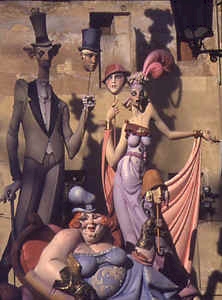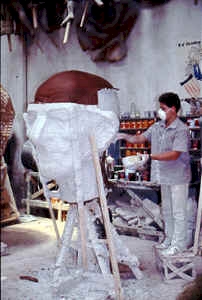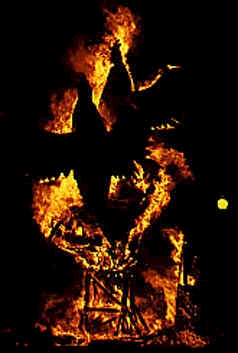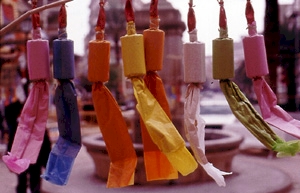|
This website is under
construction, check back soon for the final version
Welcome To Dominator Consumer Fireworks -
Info on Spanish Fireworks Festivals
|
The Falla Makers -
Combustible Fireworks Art by Nick Inman |
The fire is lit. The enormous papier mâché monument that took months to build at a cost of millions of pesetas and which received its final coat of paint only last week goes up quickly in towering flames. It's the night of March 19th, St Joseph's Day, and the awesome culmination of Valencia's annual
fireworks festival, the Fallas. For the spectators who have watched in silence, it's the end of an exhausting, week-long revel and time for a rest. But for the artists who have stood and watched their creations reduced to ashes, it's time to get back to work.
From the outside nothing distinguishes the 60-odd purpose-built workshops except the discarded white plaster-casts of objects and figures left outside for the rubbish collectors. This is Valencia's Ciudad Fallera - the "City of the
Fallas' Artists." Inside, more than 170 craftsmen inhabit a fairy-tale world under
construction. Here, you'll encounter giant flying turtles, seagulls made of crepe paper, Roman charioteers, a pirate's head five
meters high.
|
 |
It may seem like a lot of fun but it's taken very seriously. An individual falla may cost up to four million pesetas to make. Some 370 full-scale fallas - often of huge proportions - and an equivalent number of smaller, children's fallas are erected all over Valencia and another 300 in
neighboring towns.
All that means a lot of work for the city's artists: men like Juan Ruiz Recio. In his white overalls splattered with every
conceivable color of paint, Juan led us from workshop to workshop. Although it was still only July and the big night more than seven months away, everywhere men were hard at work.
A falla is a large set-piece on a given theme. Usually there's an eye-catching central feature with little scenes around it peopled by humorous figures, called
ninots. The size and complexity vary according to budget: an expensive falla can be as much as 15
meters high.
Each falla is conceived and commissioned by a neighborhood fund-raising
association. The association selects an artist who can execute their idea to a fixed budget, and work begins. It's a lengthy process, Juan told us, and calls on a variety of skills. "You have to be draughtsman, sculptor, painter and
carpenter, and a builder to put the falla together".
First, careful drawings are made. Then a scale replica of the finished object is
modeled in clay or plaster. Prizewinning artist Agustin Villanueva, showed us one such 3-D plan of a falla that his firm was making. It featured four large heads surmounted by a couple of Valencian
fisherfolk. "It represents the Mediterranean," he explained. "The heads symbolize the four great empires of antiquity."
 |
By tradition, the falla usually depicts the shortcomings of contemporary society. At the base of the model were some traditional Valencian cottages dwarfed by modern block of flats. "It's to show the invasion of cement and consumerism", said Villanueva.
The ninots are first sculpted in clay sup-ported on a crude wooden frame. A plaster cast is taken and removed in two halves to be used as a mould. This is then lined with a papier
mache' pulp made of cardboard, newspaper and glue which is left to harden. The two halves are joined together, sanded down and painted with a mixture of whiting and a special adhesive made from rabbit skin. To economize on materials, the mould can often be modified and used again.
As March approaches, the ninots are assembled on a support structure and painted in their final
colors. The completed falla -which might have taken as much as six months to build - is placed in position in a street or a square of Valencia to await the great
night of festivities and fireworks.
|
Nowadays the busy falla artist also works with quicker, modern materials such as glass
fiber. It's merely the latest development in a method which has been evolving for over 300 years.
"Some techniques have come down to us directly from the craft of making religious imagery in the Middle Ages," says Juan
Carrero, who works part time in his family's business.
The festival of the Fallas probably took shape in the 13th or 14th century when the carpenters' brotherhood began to burn their wood shavings on bonfires on the eve of the day of their patron saint, Joseph. This day also coincided with celebrations for the coming of summer, which were marked by the burning of effigies of the demons of winter.
Over time appeared the falla as we know it today - the name is believed to comes from the Latin, facula or fax, for a torch. Here and there in Valencia a group of
neighbors would get together and recruit a carpenter and a painter to make a small scene ridiculing a member of the local community. This was set up in a public place in the middle of the night. A caption in verse, in the Valencian language, was added to make sure everybody got the point. The essence of the fallas has not changed since the 18th century, the age of Baroque.
The comical figures, the ninots, became with time ever more realistic. At the beginning of this century they had clothes, real hair and waxwork faces. But today they are closer to cartoon characters than real life.
The artists of the Ciudad Fallera often work in their own family businesses. In larger workshops there is normally a master craftsman supervising and instructing artists and apprentices working under him.
The Fallas inspire good-natured rivalry among the artists of the Ciudad Fallera. They compete with each other to make their scenes ever more satirical and dramatic in size. Each year, before the Nit del Foc -Night of Fireworks - the fallas are judged in categories according to their budget. Prizes are awarded and the best creations are saved from the flames to be preserved in Valencia's Ninot museum. The artists share one ambition: to make the falla for the city's main square, the Plaza del Pais
Valenciano. This is paid for by the town hall and appears on television each year during the crema or burning.
A formal training in fine arts is not essential to be an artista fallero. Sometimes it's not even helpful. Experience and dedication to the work are the characteristics of a master of the art. Juan Ruiz became an apprentice in Ciudad Fallera when he was 15 and has learnt his trade by constant practice. For him it's a passion as much as a profession and he spends almost all his time around the "city."
To be sure that the traditional skills of falla-building will be passed on to future generations, there is now a school for artistas falleros organized among themselves. For the talented artist there isn't a short-age of work. As if the fallas of Valencia weren’t enough, they are also asked to produce smaller combustible monuments for the Hogueras de San Juan in
Alicante, to burn on Midsummer's Night. Many firms also make mobile floats for Moors and Christians processions, Battles of Flowers and many other festivals. Some have even gone beyond the busy calendar of Spanish fiestas to supply the export market.
"Come and look at the work of the Maestro," we were urged while looking around one workshop. We were led into an office and introduced to His Holiness the Pope, to Michael Jackson, Mother Theresa of Calcutta, Salvador Dali and Humphrey Bogart. They were the waxwork creations of the Maestro
Ballester. "We supply Museums in Denmark, Britain, Germany, Canada and the United States," he told us. Another master of the fallas art, Pascual
Gimeno, was carving a Red Indian emblem in clay when we arrived. His workshop too was full of familiar faces: Mickey Mouse, Snow White and King Kong to name but a few. |
 |
"They're for carnivals in America," he explained. "Fourteen or 15 years ago we stopped doing fallas because we didn't earn enough money. Now we work exclusively for the United States. They may make great bridges and sky-scrapers over there but in this kind of work we're much more advanced." Everywhere we went we met artists who, despite having to work hard for comparatively low pay, were obviously contented with their
lot. "You work more hours than a clock," said Juan Ruiz smiling, "but at least you can say, 'I enjoy it. '"
They're certainly fortunate. It's not every city that provides guaranteed employment for its artists and at the same time allows them freedom of expression. The only condition placed upon them is that most of what they produce will not survive
the next March 19th fireworks festival.
|

|
|
Spanish
Firecrackers
Article
first published in Lookout magazine.
Reprinted with permission. Copyright is held by Nick Inman. |
|
|
|
|




